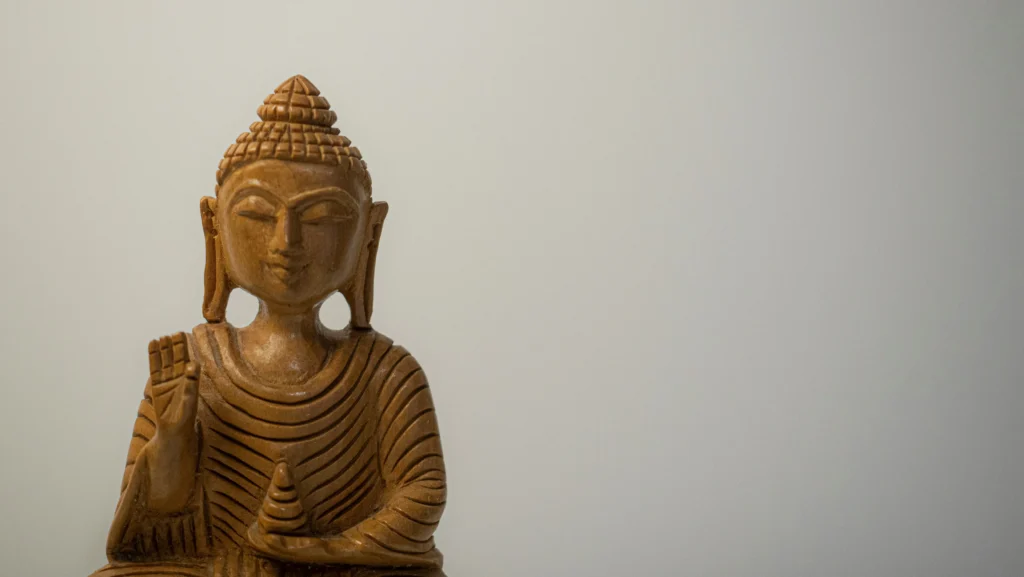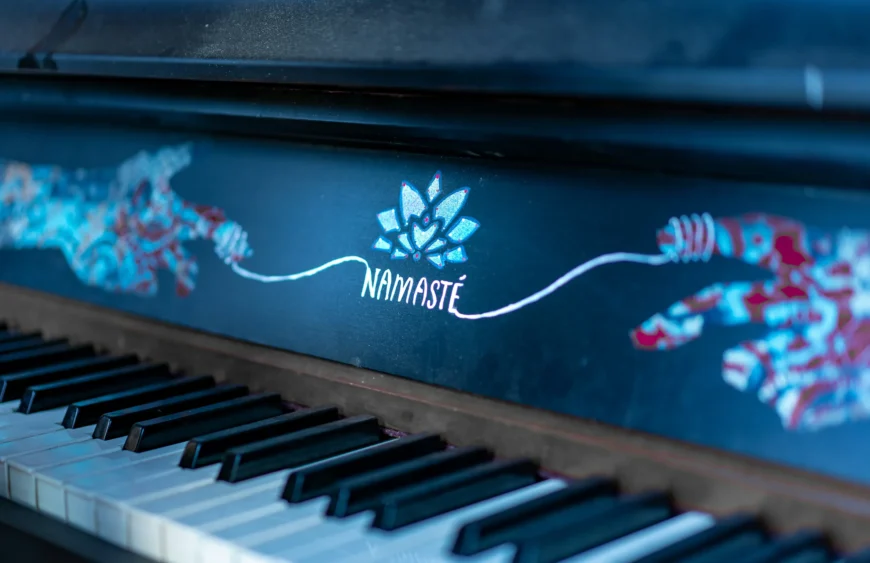Ah, Namaste. You’ve probably heard it echo through the halls of your local yoga studio or perhaps whispered it yourself after a particularly soulful meditation session. But have you ever stopped to ponder the depths of this ancient salutation? Fear not, curious minds and spiritual seekers! We’re about to unravel the mysteries of “Namaste” and why it’s so much more than a casual “hello.” Buckle up for a journey back in time and into the heart, as we explore the powerful essence of this timeless greeting.
Table of Contents
What does Namaste Mean?
It’s a term from Sanskrit meaning “I bow to you.” You join your hands at the heart, bow your head, and close your eyes. The term “namaste” combines “namaḥ,” signifying “bow, homage, worship,” with the pronoun “te,” indicating “to you.” The term “namaḥ” originates from the verb “namati,” translating to “he or she bends or bows.”
Ask any yoga practitioner about the essence of namaste meaning, and you’ll likely hear, “The divine in me salutes the divine in you.” This beautiful notion, widespread across social media, encapsulates the sentiment well, but how precise is it?
This interpretation of “the divine in you” stems from the Hindu belief that divinity is inherent in everyone, warranting respect toward all. “The gesture represents a mutual acknowledgment of the soul by each soul,” notes Palkhivala, who started his studies with B.K.S. Iyengar in his youth.
Truth #1: The Ancient Roots of Namaste
Imagine if “hello” could convey a profound spiritual message, encapsulating respect, humility, and the recognition of the divine spark within each of us. Well, guess what? That’s exactly what “Namaste” does, and it’s been doing it for thousands of years. Originating from the Sanskrit language, “Namaste” is a blend of “namah,” meaning “bow,” and “te,” meaning “to you.” So, when you say Namaste, you’re essentially bowing to the soul of the person you’re greeting. Mind-bending, right?
This ancient greeting has roots that run deep into the Vedic traditions of India, a culture that has long understood the interconnectedness of all life. In these traditions, recognizing the divine in every living being is crucial, and “Namaste” serves as a verbal manifestation of this belief. It’s a gesture that has traveled through time, from ancient scriptures to your yoga instructor’s Instagram bio, carrying with it a message of unity and respect.
Truth #2: Namaste Is a Lifestyle, Not Just a Word
Now, let’s clear up a common misconception: Namaste is not just a fancy word you can throw around to sound spiritual or cultured. It’s a lifestyle, a philosophy, a way of seeing the world. Embracing Namaste meaning living with a deep sense of respect for others, recognizing that we are all made of the same stardust, connected by the same universal energy.
Adopting a Namaste meaning lifestyle doesn’t mean you need to spend your days meditating on a mountaintop (though that does sound pretty awesome). It’s about incorporating that sense of respect and unity into your everyday interactions. Imagine approaching every conversation, every meeting, and even every conflict with the mindset that there is a divine spark within the person in front of you. How would that change the way you listen, speak, and connect?
In a world where division often takes center stage, living Namaste meaning is like being a walking, talking beacon of peace and connection. It’s about making kindness and respect so radically ordinary that they become extraordinary.

Truth #3: The Deep Spiritual Significance of Namaste
When you press your palms together at your heart chakra, bow your head, and whisper “Namaste,” you’re doing so much more than greeting another person. You’re acknowledging a profound truth: the divine spark within you sees and honors the divine spark within them. This is where the soulful magic of Namaste truly shines. It’s an acknowledgment that we are all made of the same cosmic stuff, connected by an invisible thread of universal consciousness.
This spiritual significance of Namaste meaning goes beyond religious boundaries, touching the core of our being. It serves as a reminder that beneath our external differences—our cultures, our beliefs, our social statuses—lies a deep, unifying connection. In recognizing this, Namaste meaning can be a powerful tool for spiritual awakening, a daily reminder of our shared humanity and divinity.
Imagine if every interaction began with this level of acknowledgment and respect. By embracing the spiritual essence of Namaste, we open ourselves to deeper connections, not just with others, but with the universe at large. It’s a practice of seeing and honoring the sacred in all of life, a pathway to living more compassionately and mindfully.
Truth #4: Namaste as a Universal Language of Respect
In a world brimming with diversity, Namaste emerges as a beacon of universal respect and unity. It transcends linguistic barriers, cultural differences, and religious divides, offering a simple yet profound way to connect with anyone, anywhere. This is the beauty of Namaste meaning as a universal language—it speaks directly to the heart, requiring no translation, no explanation.
Namaste’s ability to bridge worlds is particularly poignant in today’s global society, where misunderstanding and division can seem all too common. By using Namaste meaning as a gesture of respect, we’re not just saying “I see you”; we’re saying “I honor the journey that has brought you here.” It’s a way of acknowledging the struggles, the joys, the triumphs, and the sorrows that we all experience.
This universal language of respect has the power to dissolve barriers and build bridges. It reminds us that, despite our apparent differences, we share a common essence. Whether you’re greeting a neighbor down the street or a stranger across the globe, Namaste meaning has the power to create a moment of genuine connection and understanding.
Incorporating Namaste meaning into our daily interactions is a small but powerful step towards a more empathetic and unified world. It’s an invitation to pause, reflect, and recognize the inherent worth and dignity of every person we meet.

Truth #5: The Transformative Power of Understanding Namaste
Grasping the full meaning of Namaste can be nothing short of transformative. It’s like finding a secret key that unlocks a deeper, more connected way of interacting with the world. When you understand Namaste—really understand it—you start to see the invisible threads of connection that tie us all together. You recognize that each person you meet carries within them a spark of the divine, just as you do. And with this recognition comes a profound sense of responsibility and kinship.
The transformative power of Namaste lies in its ability to shift perspectives. It encourages us to look beyond the surface, to see beyond the masks we all wear. It challenges us to approach each interaction with empathy, compassion, and respect, knowing that the divine light in us honors the divine light in others. This isn’t just a philosophical ideal; it’s a practical tool for living more harmoniously, reducing conflict, and fostering understanding and respect in our interactions.
Imagine if every person you encountered, from the barista who makes your morning coffee to the colleague who’s always a bit too loud on calls, was greeted with the spirit of Namaste. How would that change the dynamics of your day? How would it change you? Understanding and embodying the essence of Namaste can transform not just individual lives but entire communities, fostering a global culture of respect, understanding, and peace.
Conclusion of Namaste Meaning
As we wrap up our exploration of “Namaste,” it’s clear that this ancient greeting holds timeless wisdom and power. From its deep spiritual roots to its transformative potential in our daily lives, Namaste is more than just a word; it’s a way of seeing and being in the world. By embracing the truths behind Namaste, we open ourselves to deeper connections, greater understanding, and a more compassionate existence. So, the next time you say Namaste, remember its profound significance and let it guide you toward more mindful and meaningful interactions. Namaste, the divine in me honors the divine in you.
FAQs Section
Q: Is Namaste meaning tied to a specific religion? A: While Namaste has its origins in Hinduism and is used in various spiritual and religious contexts in India and beyond, its essence transcends religious boundaries. It’s a universal gesture of respect and recognition of our shared humanity and divinity.
Q: Can Namaste be used in any setting? A: Absolutely! Namaste is appropriate in a wide range of contexts, from formal to casual. It’s a versatile and meaningful way to greet someone, express gratitude, or conclude an interaction, such as a yoga class.
Q: Do I need to accompany the word Namaste with the gesture of pressing my palms together? A: While the gesture adds depth and significance to the greeting, it’s not always necessary. The intention behind the word is what truly matters. However, combining the word with the gesture can enhance the feeling of connection and respect.
Q: Is it okay to use Namaste if I’m not from a culture where it’s traditionally used? A: Yes, it’s okay to use Namaste with understanding and respect for its cultural origins and significance. It’s a beautiful way to honor and connect with others, regardless of cultural background, as long as it’s done sincerely and respectfully.
For further yoga insights, visit:







